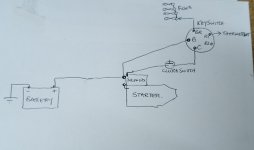Harry in Ky
Veteran Member
I'm only half way/sort of following this, but in the original post I thought I saw where someone "added a fuse to the ignition switch feed from the starter solenoid". Am I reading this correctly? There is a fuse between battery and ignition switch that's not factory? IF that's the case, my first thought is to change that. If you want a fuse in there, it should be AFTER the switch but before the ignition/accessory circuits. NOT involved in the start circuit. The start circuit can easily blow most any standard fuse in a heartbeat.
Last edited:


